The AMD Radeon R9 270X & R9 270 Review: Feat. Asus & HIS
by Ryan Smith on November 13, 2013 12:01 AM ESTPower, Temperature, & Noise
As always, last but not least is our look at power, temperature, and noise. Next to price and performance of course, these are some of the most important aspects of a GPU, due in large part to the impact of noise. All things considered, a loud card is undesirable unless there’s a sufficiently good reason – or sufficiently good performance – to ignore the noise.
| Radeon R9 270 Series Voltages | ||||
| AMD 270X Boost Voltage | HIS 270 Boost Voltage | Asus 270 Boost Voltage | ||
| 1.2v | 1.188v | 1.215v | ||
Given the lower power consumption of 270, we had expected to find the GPUs in the 270 cards would be binned on voltage, but of our limited sample that doesn’t appear to be the case. The 270X and our 270 cards are all around 1.2v. So AMD’s power savings are apparently coming off of leakage binning and clockspeed reductions.
| Radeon R9 270 Series Average Clockspeeds (Reported) | |||||
| AMD 270X | HIS 270 | Asus 270 | |||
| Boost Clock | 1050MHz | 925MHz | 975MHz | ||
| Metro: LL |
1050MHz
|
925MHz
|
975MHz
|
||
| CoH2 |
1050MHz
|
925MHz
|
975MHz
|
||
| Bioshock |
1050MHz
|
925MHz
|
975MHz
|
||
| Battlefield 3 |
1050MHz
|
925MHz
|
975MHz
|
||
| Crysis 3 |
1050MHz
|
925MHz
|
975MHz
|
||
| Crysis: Warhead |
1050MHz
|
925MHz
|
975MHz
|
||
| TW: Rome 2 |
1050MHz
|
925MHz
|
975MHz
|
||
| Hitman |
1050MHz
|
925MHz
|
975MHz
|
||
| GRID 2 |
1050MHz
|
925MHz
|
975MHz
|
||
Looking briefly at clockspeeds, as these are all PowerTune Boost 1.0 cards, the boost capabilities are very coarse grained. All of our cards report that they’re at their boost state throughout their entire benchmark runs. Unlike the 280X and 290 series these are very narrow ranges – just 25MHz to 50MHz – so our clockspeed uncertainty here from the coarse reporting is similarly low.
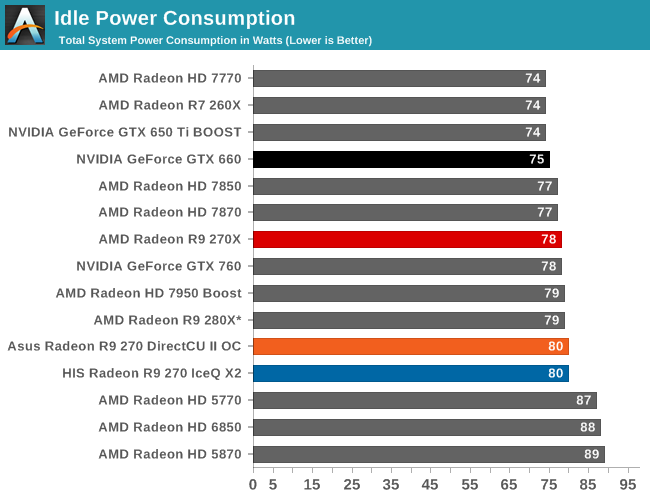
Starting as always with idle power consumption, nothing has changed since the 7800 series. At 78W for our 270X and 80W for our 270 cards, idle power consumption is fairly average, though for what it’s worth nothing here can touch the GK106 based GTX 660, which consistently measures a few watts lower at the wall.

Moving on to load power consumption, there are a few things to look at. First and foremost, because AMD is still on Pitcairn and still on TSMC’s 28nm process, power consumption has nowhere to go but higher in tandem with performance. This goes both for comparing the 270 series to the 7800 series on a hardware basis, and comparing it to the 7700 series on a price/performance basis. To that end the 270X at 267W at the wall is drawing more power than the 7870 and GTX 660, but less than the GTX 760 and quite a bit less than the 280X.
The 270 meanwhile is split. Despite the minor clockspeed differences between our 270 cards, the Asus card is drawing a total of 18W at the wall more than the HIS card. Some of this will be performance based, but for whatever reason the Asus card seems more power hungry in general. Note that in either case, this is going to be more than the GTX 660. However if we were to normalize the HIS 270 to the GTX 660’s Crysis 3 performance, the power consumption difference of 5W would likely vanish if not reverse. Though regardless, the 270 is going to be more power hungry than the outgoing 7850, despite the identical TDPs. It also means there’s a small but meaningful difference between the 150W 270 and the 130W 260X.
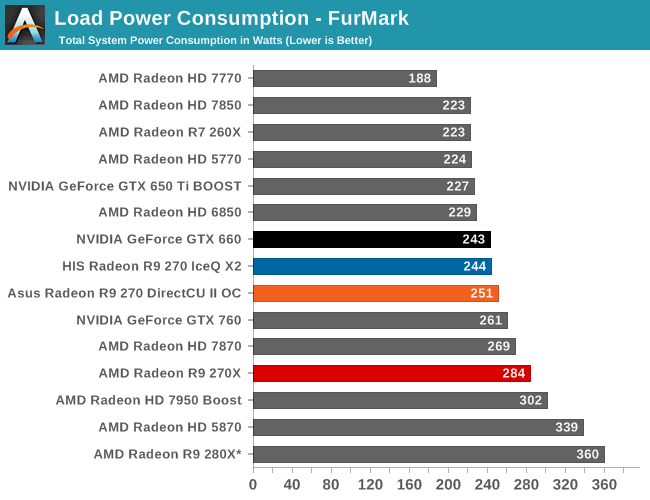
Meanwhile for FurMark, we see some compression as power consumption becomes largely a function of programmed TDP limits. All 270 series cards are exceeding their 7800 series predecessors, with the 270X approaching the power consumption of the 7850 Boost. This test also highlights the difference between the GTX 760 and 270X in maximum power consumption; the 270X will draw less power on average, but it’s ultimately rated for more than the GTX 760.
As for the 270 cards, everything clusters together. We still have a difference between the HIS and Asus cards, but at 7W it’s not nearly as much as under Crysis. More significantly we can see both the HIS 270 and GTX 660 topping out within 1W of each other, illustrating the 150W wall. 7850 by comparison is 20W less; we have always worked on the assumption that AMD was slightly overstating their TDPs on the first generation GCN products, and that would certainly be the case here. That or AMD (and NVIDIA) are exceeding PCIe specs and drawing more than 150W.
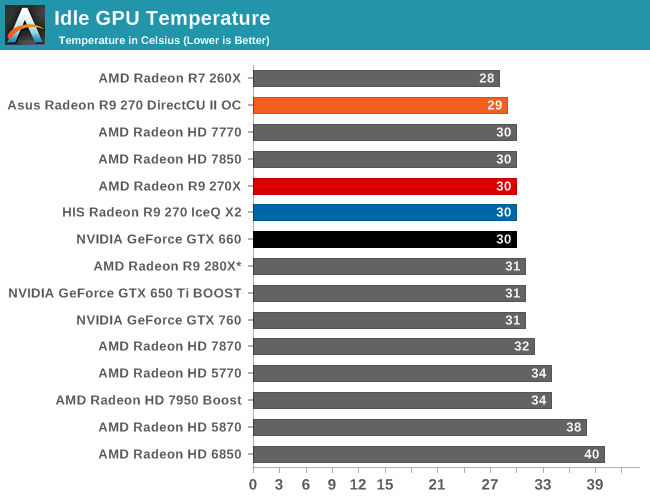
For idle temperatures there are no big surprises. Everyone is around 30C.

We’re not going to spend too much time talking about load temps/noise for the 270X since the reference design will not be for sale, but briefly we can see that AMD’s blower lets it get relatively warm. Though nothing here tops the GK104 based GTX 760 and its 80C throttle point.
Otherwise for the 270 cards, both of them are going to be significantly cooler than the GTX 660. Again owing to the difference between a blower and an open air cooler, the 270 cards are 8 to 11 degrees cooler. Between the two of them HIS will have the edge at 61C, though we’re going to have to look at noise to get the full picture.
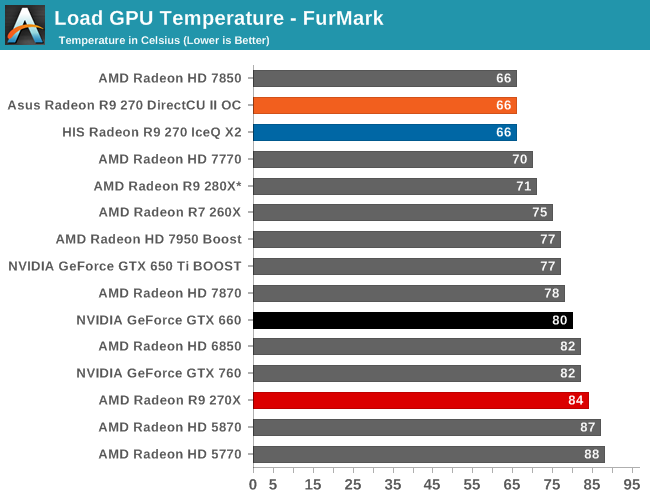
FurMark further drives a wedge between blowers and open air coolers, with the open air based 270 cards now operating 14C cooler than the GTX 660. However the reference 270X suffers similarly; AMD’s cooler loses some ground, letting the card rise to 84C.

Finally for our look at noise, the results are fairly typical for every card except the Asus. Asus’s 270 by comparison to everything else now holds the new record for quietest card on our current testbed, coming in at just 36dB. It’s quiet enough that we had to double check if the fans were running, as they are hard to hear at this noise level even with our case cracked open. The Asus card can’t by definition be silent, but quiet computing enthusiasts should be quite pleased at idle.
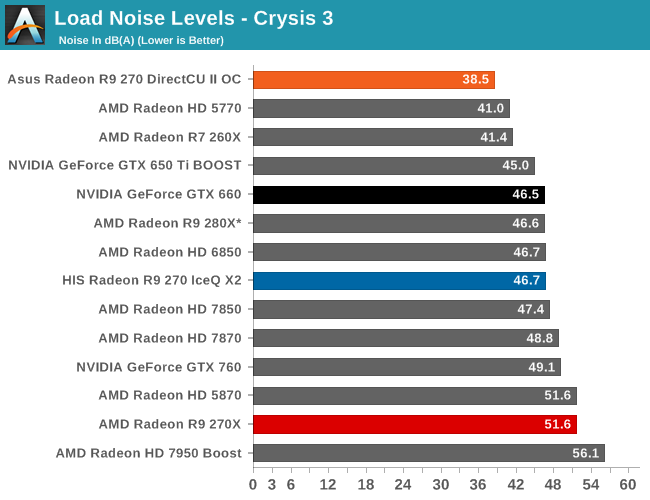
As for load noise, we can briefly see that he 270X isn’t going to be particularly impressive. Besides operating at a higher temperature than the GTX 760, it’s also louder. We really want to see at least some blower options for 270X, but AMD’s reference blower struggles with the task.
For the 270 cards on the other hand, the outcomes are mixed. The blower based GTX 660 for its part does rather well despite the handicap; the HIS card is actually marginally louder even though it’s open air. For this class of card the HIS is rather typical in cooling performance, but it means it’s in a crowd.
The Asus card meanwhile almost requires a new chart of its own just to put it in perspective. Asus has been impressing us lately with their DirectCU II coolers, and this is one example of why. 38.5dB is quieter than half of these cards at idle; that’s how quiet Asus’s 270 is. The HIS card can’t match it, and even the lower powered open air 5770 can’t match it. As far as open air coolers go, Asus is approaching the pinnacle of performance here, fully exploiting the advantage the design offers, and making their 270 significantly quieter than the GTX 660.

Furmark further drives a wedge between the Asus 270 and everything else. It’s still under 40dB here, more than 7dB quieter than the GTX 660 or the HIS 270. From a noise perspective it really is that much better, and since we’ve already seen the temperature data we can safely say that it hasn’t come at the cost of significant temperature increased. Though as always we have to be clear that we’re looking at an open air cooler versus a sea of blowers here, so the usual precautions about trade-offs apply.










59 Comments
View All Comments
P39Airacobra - Saturday, July 26, 2014 - link
The 660 is great card but compared to the R9 270 non X it looses by a good margin (but the 660 has much better drivers). The GTX 760 wins against the 270. So the 270 fits in a very good spot especially for $179, And newegg even has a saphire R9 270 for $154. Nvidia can't come close to that price/performance.P39Airacobra - Thursday, August 14, 2014 - link
I really like my HIS R9 270 iPower IceQ X² card, When I buy a GPU I always try to get one with reference clocks especially if it's a AMD GPU. This can save some trouble with drivers issues. My 650 Ti was also based on reference clocks. And if you need the extra FPS you can always overclock. But honestly it is always best to leave the clocks alone. The performance gain from overclocking at the most will be 5fps average, That really is not worth fooling with. If your card won't get enough FPS in a certain game with certain settings it makes much more sense just to turn down the settings a little bit instead of stressing your expensive GPU. However at 1080 any 7870/270/270X should be fine a High-Ultra settings anyway.P39Airacobra - Tuesday, September 30, 2014 - link
Well I edited a copy of my bios on a HIS R9 270 ICE QX2 with Hynix, I set it to boot at stock AMD X model Voltage and I upped the fan profile a little bit to compensate, And I set the CCC oc limit to stock X model also. So it will boost to 1050mhz and 1.2v. But of'course I am too chicked too try and flash it. LOL, I am too afraid to ruin a good card that cost over $150 bucks. That's allot of money down the drain over simple flash risk.P39Airacobra - Tuesday, September 30, 2014 - link
It would be nice if somone would do a crossfire review for the 270 nonX. Since it is the best bang for buck card with performance close to high end you would think they would. This card is also very popular because of it's performance and price. So WTH reviewers?P39Airacobra - Saturday, October 18, 2014 - link
I have to say again! I love the 270 series from AMD! AMD has finally corrected the artifact issues with the latest 14.9 and 14.91 Beta drivers! That is outstanding! I am so glad to finally see AMD with drivers as good as Nvidia's. The R9 270 is the perfect GPU! It can run anything at 1080p with absolutely beautiful settings! And you can now buy a R9 270 for $139 at newegg. This is a card that can do anything! And it is only $139. That is outstanding! It is the HIS model like mine too! http://www.newegg.com/Product/Product.aspx?Item=N8... I am a little mad since I paid $179 for mine LOL. But if it helps other people to game. Anyway I can vouch that this card runs very cool too. It has a excellent cooler with copper pipes, The only drawback is it does not have heatsinks on the V-Ram, So do not overclock the V-Ram ever! But it runs 24c-28c idle, And never gets to 60c under heavy load clocked at 1050mhz. At stock 925mhz it never gets past 54c. That is outstanding temps for a Pitcairn chip. If you need a upgrade or are deciding on a GPU for a new build, This card for $139 is a fantastic choice.P39Airacobra - Saturday, October 25, 2014 - link
I noticed a really neat thing running CPU-Z log during game play. (Hitman Absolution) I was just curious of the boost clock speed. I wanted to see what clock speed it ran at. But it actually just runs at the labeled boost clock speed. The log showed It staying at 925mhz from the start of the game. So I was glad to see it at that speed. Here is the interesting part. When I looked at the voltage section of the log the card mostly ran at it's labeled voltage, But it also spiked at 1.250 which is the actual peak voltage for most 7870's. So it is nice to know my HIS R9 270 has same potential as the 7870 and R9 270X. The auto voltage is kinda neat. I also noticed my highest temp was 52c. I thought everyone said AMD cards run hot. I never seen this one go to 60c. I think I will just stick with my R9 270 for another 2 years. And hopefully ny then AMD will have another great bang for buck GPU like the R9 270. I was sold on Nvidia but now that AMD finally improved their drivers and removed the artifacts from Mafia 2, they seem to be finally caring about their drivers. I also noticed that textures on AMD GPU's look sharper, clearer and much cleaner than Nvidia. Also AMD's colors are much nicer, Nvidia's colors seem stale and dull now after using my R9 270.shredder962 - Thursday, November 27, 2014 - link
Late comment, but to those saying the 270 is a nerfed 270x are full of it.https://i.imgur.com/wU3qUII.png
This is my Asus Radeon R9 270 CUII OC overclocked to match the boost clock of the Gigabyte Radeon R9 270X Windforce Edition
Boo Yoon - Friday, December 11, 2015 - link
Hi,I am ignorant of a graphic card thing as a college female student and i was wondering if AMD Radeon R9 290 can support a monitor that I am going to buy. The monitor model name is 'QX2710 LED Evolution ll DP Multi TRUE10 TRUE 10 Matte 27" 2560x1440 Monitor' and it has a DVI-D, HDMI, VGI, and DP inputs. Somebody help me to know if the monitor is okay to buy for my graphic card. Thank you.
Loretta946 - Wednesday, October 3, 2018 - link
Most importantly, the recipe is totally devoid of corn, wheat and soy. https://dogbedoptions.sitey.me/ The appearance of the food functions to provide your pet dog's teeth.